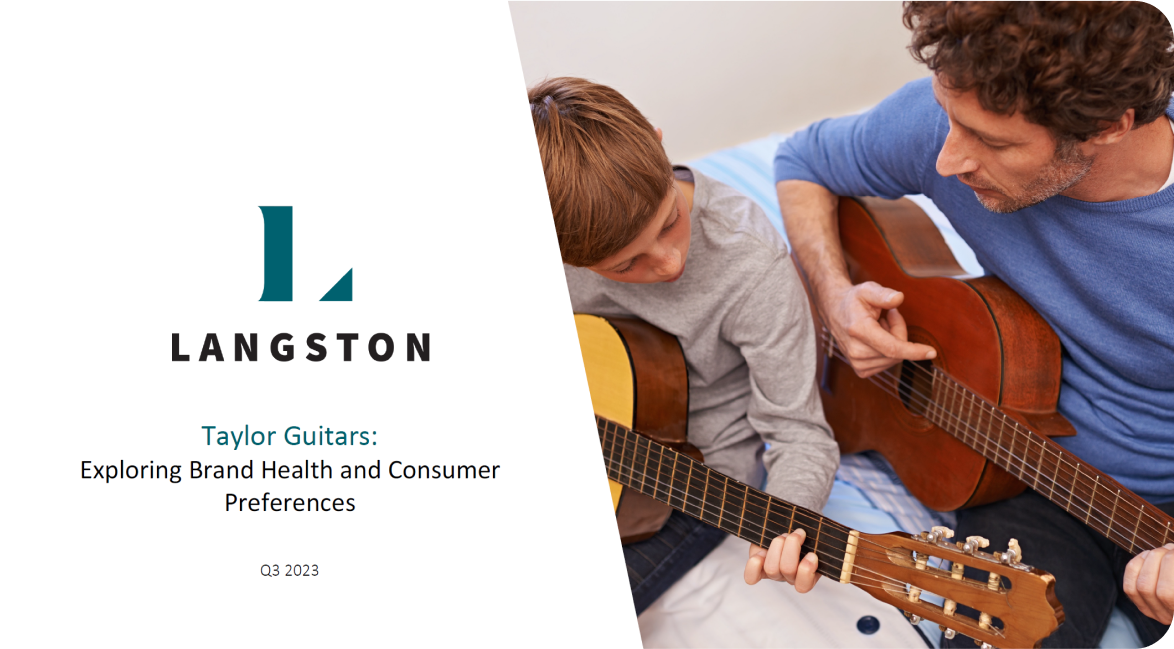Guitar Market Brand Health and Consumer Preferences
Case Study
Published Q3 2023
With Taylor Guitars as the focal brand throughout this study, we explored the guitar market’s competitive set and consumer behaviors. This study, conducted in August 2023, provides an example of how Langston approaches, operationalizes, and reports brand health and positioning, consumer willingness to pay, and consumer usage, habits, and preferences.
Overview
It’s hard to imagine a category where knowing your consumers’ needs and motivations is more important than musical instruments, especially guitars. From meeting players’ preferences for materials and price range to understanding their skill level and eventual musical aspirations, winning in this category requires a full and complete understanding of the consumer.
This case study, conducted in 2023 among guitar players in the US, puts Taylor Guitars in the spotlight and explores what the brand can do to win with the modern guitarist.
This case study also showcases how Langston approaches, operationalizes, and reports brand health and positioning, consumer willingness to pay, and consumer usage, habits, and preferences.
Taylor Guitar’s mission is to improve the guitar-playing experience. In an industry surrounded by heritage giants (such as Yamaha, Gibson, and Fender), Taylor works to build its legacy through a commitment to quality and innovation. Highly regarded as a leader in the guitar space, Taylor strives to compete with other brands as a premier retailer and manufacturer of acoustic and electric guitars.
In this report, we use our modular research method to explore the key areas of opportunity for Taylor via identifying the brand’s overall health and position in the market, consumers’ willingness to spend, and what guitar players are actually seeking out of these brands and their products.
Insights
Insight 1: With one out of every two consumers aware of Taylor guitars, the brand has a strong position in the overall guitar market and is positioned as an industry leader.
That said, Taylor performs at best on par – more likely below – with other industry leaders such as Yamaha, Gibson, Fender, and Martin on key funnel metrics. Taylor continues to lag further against its core competitors as the funnel progresses, suggesting that the brand may have an “I’ve heard of it” problem.
Insight 2: Brand is the top driver of product decisions in the space, and consumers are willing to pay high premiums for the brands they are most loyal to. Consumers are willing to invest in the brands they find most trusted.
Brand’s high relative importance suggests that the name behind a guitar seems to be the first consideration when selecting what to purchase. Price, on the other hand, is evidentially secondary to consumers as their primary concerns seem to revolve around brand reputation and the guitar’s functionality. The importance of functionality is illustrated by the weight consumers put towards the tuner/pickup.
Consumers are brand driven and price insensitive in this market. These guitar players are loyal to the brands they trust most, making name value a huge commodity towards individual product selection. The chart below illustrates that consumers who prefer Taylor are consistently more likely to select a Taylor guitar for $1,750 over another brand’s product for $500 less. 27% of consumers would buy the higher priced Taylor over Fender, 34% would pay more for Taylor over Martin, and nearly one out of every two consumers would buy the more expensive Taylor guitar over that of Ibanez.
Insight 3: Taylor’s target audience lives with guitar playing enthusiasts over a universal market approach. These consumers are already more invested in Taylor’s brand – with higher rates of conversion at integral stages of the funnel – and are the most likely to spend on products in the category.
Consumers who identify playing guitar as their number one hobby over a general hobby amongst others – also known as “enthusiasts” – are more likely to know what Taylor stands for than the total market and have plenty of overlap with intermediate and advanced players, making them a prime audience for Taylor to target.
Insight 4: Taylor successfully establishes trust amongst consumers, giving them permission to play in the space; and by focusing innovation towards making the guitar playing experience smoother, easier, more convenient, the brand is likely to build up their reputation and get even bigger buy-in from potential and current customers.
Innovative is one of the top appealing traits to consumers in this market – following trustworthy and alongside genuine, classic, and traditional – making it all the better that this is an area Taylor already finds success and association. In developing and messaging towards novelty and enhanced functionality, Taylor will be able to become the All-Star in the space.
DISCLAIMER: We base our research, recommendations, and forecasts on techniques, information and sources we believe to be reliable. We cannot guarantee future accuracy and results. The Langston Co. will not be liable for any loss or damage caused by a reader's reliance on our research.
More insights, more data. Download this study to learn more.
In order to conduct unbiased and objective research, this study was privately funded by The Langston Co. We did not receive endorsement or financial support of any kind from any third party.
Thanks for taking time to read our research. With questions, comments, or suggestions about this study, please contact us at contact@thelangstonco.com.










